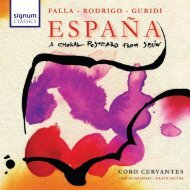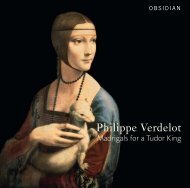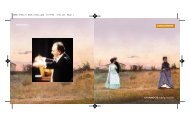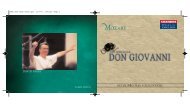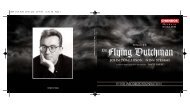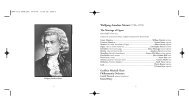Candlemas in Renaissance Rome Le Divin ArcADeLt - Chandos
Candlemas in Renaissance Rome Le Divin ArcADeLt - Chandos
Candlemas in Renaissance Rome Le Divin ArcADeLt - Chandos
- No tags were found...
Create successful ePaper yourself
Turn your PDF publications into a flip-book with our unique Google optimized e-Paper software.
CHANDOS early music<strong>Le</strong> Div<strong>in</strong> ArcadeltDe Silva • Palestr<strong>in</strong>a<strong>Candlemas</strong> <strong>in</strong> <strong>Renaissance</strong> <strong>Rome</strong>Musica Contextawith The English Cornett and Sackbut Ensemble
Giovanni Pierluigi da Palestr<strong>in</strong>a© <strong>Le</strong>brecht Music & Arts Photo Library
<strong>Le</strong> Div<strong>in</strong> Arcadelt:<strong>Candlemas</strong> <strong>in</strong> <strong>Renaissance</strong> <strong>Rome</strong>premiere record<strong>in</strong>gs, except*Jacques Arcadelt (c. 1507 – 1568)1Pater noster 6:01Motet2Hodie beata virgo Maria 3:23MotetChant3Suscepimus, Deus 3:16IntroitusJacques Arcadelt4Kyrie from Missa ‘Ave, Reg<strong>in</strong>a caelorum’ 4:215Gloria from Missa ‘Ave, Reg<strong>in</strong>a caelorum’ 5:24Chant6Suscepimus, Deus 1:09Graduale3
Giovanni Pierluigi da Palestr<strong>in</strong>a (c. 1525 – 1594)7Senex puerum portabat* 7:31MotetJacques Arcadelt8Credo from Missa ‘Ave, Reg<strong>in</strong>a caelorum’ 9:18Giovanni Pierluigi da Palestr<strong>in</strong>a9Diffusa est gratia* 2:42OffertoryChant10Nunc dimittis 2:11TractusJacques Arcadelt11Sanctus from Missa ‘Ave, Reg<strong>in</strong>a caelorum’ 5:414
Chant12Responsum accepit Simeon 0:55CommunioAndreas de Silva (c. 1475 / 80 – c. 1530)13Inviolata, <strong>in</strong>tegra et casta es Maria 5:29MotetJacques Arcadelt14Agnus Dei from Missa ‘Ave, Reg<strong>in</strong>a caelorum’ 4:57Andreas de Silva15Ave, Reg<strong>in</strong>a caelorum 5:44MotetMusica ContextaSimon Ravens directorwithThe English Cornett and Sackbut EnsembleTT 68:145
Musica ContextasopranoStephen Shellard<strong>Le</strong>onora Dawson-Bowl<strong>in</strong>gAndra PattersonaltoSimon LillystoneSamir SavantPeter NorthtenorPatrick AlliesAndrew HopeSimon RavensbassChris HunterPhilip PrattEdmund Sadd<strong>in</strong>gton6
The English Cornett and Sackbut EnsembleGawa<strong>in</strong> GlentonEmily WhiteTom <strong>Le</strong>esAndrew Harwood-Whitesoprano cornett (440) Gawa<strong>in</strong> Glenton by Serge Delmas, Paris 2004, afterVenetian orig<strong>in</strong>alsmute cornett (440) Gawa<strong>in</strong> Glenton by Christoph Schuler, Langenthal(Switzerland) 2007alto sackbut (E flat) Emily White <strong>Renaissance</strong> style by Egger, Basel 1998,after Hieronimus Starck, Nuremberg 1670,now <strong>in</strong> Germanisches Nationalmuseum,Nurembergtenor sackbut (B flat) Emily White <strong>Renaissance</strong> style by Egger, Basel 1998,after Sebastian Ha<strong>in</strong>le<strong>in</strong>, Nuremberg 1632,now <strong>in</strong> Historisches Museum, FrankfurtTom <strong>Le</strong>es <strong>Renaissance</strong> style by Egger, Basel 1990,after Sebastian Ha<strong>in</strong>le<strong>in</strong>, Nuremberg 1632,now <strong>in</strong> Historisches Museum, Frankfurtbass sackbut (E flat or F) Andrew Harwood-White <strong>Renaissance</strong> style by Egger, Basel 1995,after E flat <strong>in</strong>strument by Isaac Ehe,Nuremberg 1612, now <strong>in</strong> GermanischesNationalmuseum, Nuremberg7
<strong>Le</strong> Div<strong>in</strong> ArcadeltIt is the most blessed varietie <strong>in</strong> theworld, where a man may goe to so manyChurches <strong>in</strong> one day, chose where he wil,so heavenly served, with such musicke,such voices, such <strong>in</strong>struments, al fulof gravitie and majestie, al mov<strong>in</strong>g todevotion and ravish<strong>in</strong>g a mans hart tothe meditation of Angels and Sa<strong>in</strong>tes <strong>in</strong>heaven. With the Organs a childes voiceshriller and louder than the <strong>in</strong>strument,tuneable with every pipe: Among thequyre, Cornet or Sagbut, or such likeabove al the other voices. (GregoryMart<strong>in</strong>, Roma Sancta, 1588)It is easy for modern performers, prepar<strong>in</strong>g apiece of Italian <strong>Renaissance</strong> music, to imag<strong>in</strong>ethat we are quest<strong>in</strong>g for some k<strong>in</strong>d of HolyGrail: just by establish<strong>in</strong>g the context for whicha piece was written, we tell ourselves, we candiscover the one true way of mak<strong>in</strong>g the musicshimmer. The chief flaw with this historicalquest for authenticity is that Italian <strong>Renaissance</strong>musicians themselves would not have recognisedit. Their music showed none of our kid-glovereverence for the past, and their approach toperform<strong>in</strong>g it was anyth<strong>in</strong>g but s<strong>in</strong>gular.This record<strong>in</strong>g, then, does not attemptto reconstruct a s<strong>in</strong>gle context <strong>in</strong> which themusic of de Silva, Arcadelt, and Palestr<strong>in</strong>amight have been heard. Indeed, althoughat various times they were all members ofthe same choir, there is no evidence thatthe music presented here was ever sung at as<strong>in</strong>gle service. Rather, we take the ecstaticdescription by Gregory Mart<strong>in</strong> of the musiche heard <strong>in</strong> the churches of <strong>Rome</strong> as a start<strong>in</strong>gpo<strong>in</strong>t for a quest with many grails to discover.How real were these grails? Whilst Mart<strong>in</strong>,a fervent English Jesuit, perhaps exaggeratedthe quality of music <strong>in</strong> Papal <strong>Rome</strong>, thereis good evidence from other sources thathe was not fabricat<strong>in</strong>g about the nature ofthe ensembles he heard. So we can imag<strong>in</strong>eourselves, <strong>in</strong> company with Mart<strong>in</strong>, walk<strong>in</strong>gthe streets of <strong>Rome</strong> on the morn<strong>in</strong>g of2 February – the Feast of the Purification –some time at the end of the sixteenth century.At each major church we come to we enterand listen to a musical item. In one churchwe f<strong>in</strong>d a s<strong>in</strong>gle falsettist accompanied bysackbuts, <strong>in</strong> another an unaccompanied choir.Mov<strong>in</strong>g further on, we f<strong>in</strong>d a group of s<strong>in</strong>gers8
with a solo cornett, and elsewhere a full choirwith w<strong>in</strong>d <strong>in</strong>struments. Perhaps a sneak<strong>in</strong>gcuriosity leads us back to some churches,which expla<strong>in</strong>s how we hear the same scor<strong>in</strong>gmore than once. In this roundabout way, afterthe irresistible benediction of the Pater nosterby Arcadelt, by happy chance we come to hearall his Ave, Reg<strong>in</strong>a caelorum mass, along withthe motet on which it was based, and severalpropers – items specific to the Feast of thePurification.There is one obvious reason why <strong>Rome</strong>played host to such a variety of musicalpractices dur<strong>in</strong>g the <strong>Renaissance</strong>. Despitebe<strong>in</strong>g a net exporter of religious customs andjurisdiction, musically <strong>Rome</strong> was very much animporter. In this melt<strong>in</strong>g-pot of national styles,one of the strongest <strong>in</strong>fluences came fromIberian musicians (a term which here embracescomposers and performers – the dist<strong>in</strong>ctionbe<strong>in</strong>g more ours than theirs). The participationof w<strong>in</strong>d <strong>in</strong>struments <strong>in</strong> Roman churches maywell have come from Spa<strong>in</strong>, as did the practiceof soprano falsettists and, <strong>in</strong> the latter partof the sixteenth century, castrati. It has beensuggested (admittedly on little more evidencethan the sound of his name) that Andreasde Silva (c. 1475 / 80 – c. 1530) was born <strong>in</strong>Spa<strong>in</strong>, before mov<strong>in</strong>g to Italy. Like so manycomposers of his era, de Silva has been cast<strong>in</strong>to obscurity by the blaz<strong>in</strong>g star of Josqu<strong>in</strong>:to judge from the two works presentedhere, this seems unjust <strong>in</strong> the extreme. Yetbiographically too, de Silva is someth<strong>in</strong>g of ashoot<strong>in</strong>g star, s<strong>in</strong>ce his movements can onlybe accounted for between 1513 and 1522.With<strong>in</strong> this brief period, de Silva was for twoyears ‘cantor et compositor’ of the CappellaSist<strong>in</strong>a <strong>in</strong> <strong>Rome</strong>, and it is <strong>in</strong> the Sist<strong>in</strong>earchive that his motet Ave, Reg<strong>in</strong>a caelorumsurvives. There is also evidence that de Silvaspent time work<strong>in</strong>g <strong>in</strong> northern Italy: hisInviolata, <strong>in</strong>tegra et casta es Maria is found<strong>in</strong> a manuscript from Bologna.Spa<strong>in</strong> aside, the other greatest regional<strong>in</strong>fluence on the music of the Italian<strong>Renaissance</strong> was that of northern France andthe Low Countries. It was from here (thereis no evidence exactly where) that JacquesArcadelt (c. 1507 – 1568) arrived <strong>in</strong> northernItaly <strong>in</strong> the early 1530s. After a decade <strong>in</strong> thenorth, he travelled south to <strong>Rome</strong>. Betweenabout 1539 and 1551, he was a member of theCappella Sist<strong>in</strong>a, and it was almost certa<strong>in</strong>lyhere that he came across de Silva’s Ave, Reg<strong>in</strong>acaelorum motet. Evidently it made a strongimpression on Arcadelt, for he used it as thebasis of his Missa ‘Ave, Reg<strong>in</strong>a caelorum’.In our own age, this k<strong>in</strong>d of artisticappropriation would be deemed (at least9
<strong>in</strong> the eyes of the law) as be<strong>in</strong>g to de Silva’sdetriment. In the <strong>Renaissance</strong>, Arcadelt’sgesture would have been regarded as pay<strong>in</strong>gde Silva the highest compliment. (Perhaps notquite: the highest compliment offered tode Silva may have been the attribution of someof his music to Josqu<strong>in</strong>.) Even today, though,Arcadelt could have deflected any charge ofplagiarism by po<strong>in</strong>t<strong>in</strong>g out that the melodywhich gave de Silva his <strong>in</strong>spiration – theGregorian chant ‘Ave, Reg<strong>in</strong>a caelorum’ – wasitself borrowed. De Silva updates the chantto make it more tonally focused. In his turn,Arcadelt – at heart an affective madrigalist –subtly tweaks de Silva’s approach to textureand word sett<strong>in</strong>g to place the mass firmly <strong>in</strong>the post-Josqu<strong>in</strong> era. Unabashed humanism,one senses, is not far away. Nor is it <strong>in</strong>Arcadelt’s motets. On paper, Arcadelt’s Paternoster and Hodie beata virgo Maria appearworlds apart – the former as sumptuous as thelatter is simple – but at their core is the samedirect appeal to our emotions.In the year that Arcadelt left <strong>Rome</strong> toreturn north to France, Giovanni Pierluigida Palestr<strong>in</strong>a (c. 1525 – 1594) arrived <strong>in</strong> thecity. Born only a short distance from <strong>Rome</strong>,Palestr<strong>in</strong>a was part of a grow<strong>in</strong>g wave ofnative Italian musical talent. The legend thatPalestr<strong>in</strong>a s<strong>in</strong>gle-handedly synthesised thecompet<strong>in</strong>g spiritual and humanist aestheticsof the time has become commonplace.However mythical the biographical detailssurround<strong>in</strong>g the role of Palestr<strong>in</strong>a <strong>in</strong> thisreconciliation may be, his music provides allthe testimony we need that the composerdid <strong>in</strong>deed fuse these different elements. Theclarity of Palestr<strong>in</strong>a’s writ<strong>in</strong>g – exemplifiedhere by the late work Diffusa est gratia – hasalways been realised. Perhaps, however, it hasbeen realised at the expense of the emotionalresponse which Palestr<strong>in</strong>a showed to his texts.Senex puerum portabat, an earlier work,seems to radiate this quality.In one other respect, Palestr<strong>in</strong>a playeda vital role <strong>in</strong> the music of the Counter-Reformation. In 1577 he was commissionedby Gregory XIII to co-edit the exist<strong>in</strong>gRoman Gradual, to rid the chant of its‘superfluities, barbarities, and obscurities’:<strong>in</strong> other words, to modernise chant <strong>in</strong> thespirit of humanism. In fact, this huge taskwas only completed <strong>in</strong> 1614 by two disciplesof Palestr<strong>in</strong>a, Felice Anerio (c. 1560 – 1614)and Francesco Soriano (1548 / 49 – 1621).This ‘Medicean’ chant was re-published as theGraduale Romanum <strong>in</strong> 1871 by Palestr<strong>in</strong>a’sfirst modern editor, Franz Xaver Haberl,and this is our source for the chant. It mayseem perverse that we should present versions10
of chant – the Introit ‘Suscepimus, Deus’,the Gradual ‘Suscepimus, Deus’, the Tract‘Nunc dimittis’, and the Communion‘Responsum accepit Simeon’ – that couldnot have existed at the time <strong>in</strong> which wehave placed this record<strong>in</strong>g – the end of thesixteenth century. In spirit, however, theseabbreviated chants were very much alive <strong>in</strong>the <strong>Rome</strong> of the late <strong>Renaissance</strong>.Those look<strong>in</strong>g for absolute authenticities<strong>in</strong> this record<strong>in</strong>g’s cross-section of musicalhistory, then, will search <strong>in</strong> va<strong>in</strong>. As weimag<strong>in</strong>e ourselves wander<strong>in</strong>g randomlythrough the sun-spanked streets of GregoryMart<strong>in</strong>’s <strong>Rome</strong>, and enter<strong>in</strong>g its soundworld, we might heed Richard Tarusk<strong>in</strong>’sobservation that ‘there are no orig<strong>in</strong>s and nodest<strong>in</strong>ations <strong>in</strong> such histories, only stages’.© 2011 Simon RavensFormed <strong>in</strong> 1993 and based <strong>in</strong> London,The English Cornett and Sackbut Ensembleis a virtuoso period <strong>in</strong>strument group atthe forefront of the early music scene. It hasperformed at most of the major music festivals<strong>in</strong> the UK, given sell-out concerts at theWigmore Hall, St John’s, Smith Square, andPurcell Room <strong>in</strong> London, and toured France,Canada, and Israel. In 2011 it will make itsdebut at the Three Choirs Festival with TheRoyal Holloway College Chapel Choir andvisit Turkey and Florence with the renownedchamber choir I Fagiol<strong>in</strong>i. The Ensemble canoften be heard on BBC Radio 3 and Radio 4,as well as on Classic FM, and has also broadcastlive from the concert lobby of Classical96.3 FM <strong>in</strong> Toronto. It has participated <strong>in</strong>Evensong alongside the Choir of His Majesty’sChapel Royal at St James’s Palace and the RoyalHolloway College Chapel Choir <strong>in</strong> the RoyalHolloway Chapel, both services broadcast onBBC Radio 3. The English Cornett and SackbutEnsemble has made numerous record<strong>in</strong>gs, mostrecently of Alessandro Striggio’s forty-part Masswith I Fagiol<strong>in</strong>i, and has also collaborated withchamber choirs such as The Rodolfus Choir,The Choir of K<strong>in</strong>g’s College, London, and theArmonico Consort. www.ecse.co.ukMusica Contexta translates literally as ‘music<strong>in</strong>terwoven’, reflect<strong>in</strong>g the group’s primaryaim of present<strong>in</strong>g <strong>Renaissance</strong> music <strong>in</strong>the context of its orig<strong>in</strong>al conception andfunction. The group gave its first performance<strong>in</strong> August 1992, <strong>in</strong> Ely Cathedral, andmade its London debut at St John’s, SmithSquare the follow<strong>in</strong>g year. S<strong>in</strong>ce then it hasperformed throughout Great Brita<strong>in</strong> andcont<strong>in</strong>ental Europe. It has made sell-out11
appearances at the York Early Music Festival,Three Choirs Festival <strong>in</strong> Worcester Cathedral,and Stour Music Festival <strong>in</strong> Kent, amongothers. The group’s Wigmore Hall debut wasonly one of a number of appearances broadcastby the BBC. Musica Contexta made its firstCD record<strong>in</strong>g, of music by John Sheppard, <strong>in</strong>1995. This was followed by a highly acclaimedseries of record<strong>in</strong>gs for <strong>Chandos</strong> featur<strong>in</strong>gPalestr<strong>in</strong>a’s music for Holy Week; the f<strong>in</strong>alrecord<strong>in</strong>g <strong>in</strong> this series was short-listed for theprestigious Gramophone Early Music Award.Carol<strong>in</strong>e CurryFrom the record<strong>in</strong>g sessions12
<strong>Le</strong> Div<strong>in</strong> ArcadeltEs ist die gesegnetste Mannigfaltigkeitder Welt, wenn e<strong>in</strong> Mann an e<strong>in</strong>eme<strong>in</strong>zigen Tag so viele Kirchen besuchenkann, wählen kann was er will, sohimmlisch ausgestattet mit solcherMusik, solchen Stimmen, solchenInstrumenten, alle voller Gravität undMajestät, alle der Andacht förderlich,und alle das Herz e<strong>in</strong>es Mannesermunternd zur Meditation über dieEngel und die Heiligen im Himmel.Zu den Orgeln erkl<strong>in</strong>gt die Stimmee<strong>in</strong>es K<strong>in</strong>des, schriller und lauter als dasInstrument, sich auf den Klang e<strong>in</strong>erjeden Pfeife e<strong>in</strong>stimmend: Zum Chorgesellen sich Z<strong>in</strong>ken und Posaunen oderdergleichen vor allen anderen Stimmen.(Gregory Mart<strong>in</strong>, Roma Sancta, 1588)Für moderne Musiker, die e<strong>in</strong> Werk deritalienischen <strong>Renaissance</strong> e<strong>in</strong>studieren, istes e<strong>in</strong> <strong>Le</strong>ichtes, sich vorzustellen, dass wiruns gerade auf der Suche nach e<strong>in</strong>er Artheiligem Gral bef<strong>in</strong>den: Indem wir denKontext rekonstruieren, für den e<strong>in</strong> Stückgeschrieben wurde – so sagen wir uns –,können wir die e<strong>in</strong>zig richtige Methodeentdecken, dieser Musik ihren Glanzzu verleihen. Der größte Schwachpunktan diesem Streben nach historischerAuthentizität liegt allerd<strong>in</strong>gs dar<strong>in</strong>, dassitalienische Musiker der <strong>Renaissance</strong> dieseselber nicht erkannt hätten. Ihre Musik zeigtnichts von unserer samtbehandschuhtenEhrfurcht vor der Vergangenheit, und ihreAufführungsmethoden waren alles andere alss<strong>in</strong>gulär.Diese E<strong>in</strong>spielung versucht daher nicht,e<strong>in</strong>en def<strong>in</strong>itiven Kontext zu etablieren, <strong>in</strong> demdie Musik von de Silva, Arcadelt und Palestr<strong>in</strong>aerklungen se<strong>in</strong> könnte. In der Tat – obwohldie drei zu verschiedenen Zeiten demselbenChor angehörten, gibt es ke<strong>in</strong>erlei Indiz dafür,dass die hier vorgestellten Werke je zusammen<strong>in</strong> e<strong>in</strong>em e<strong>in</strong>zigen Gottesdienst gesungenwurden. Vielmehr nehmen wir GregoryMart<strong>in</strong>s ekstatische Beschreibung der von ihm<strong>in</strong> den Kirchen Roms vernommenen Musikals Ausgangspunkt für e<strong>in</strong>e Suche, auf der esviele Grale zu entdecken gilt. Wie real warendiese Grale? Während Mart<strong>in</strong>, e<strong>in</strong> glühenderenglischer Jesuit, die Qualität der Musik impäpstlichen Rom vielleicht übertrieb, gibt es13
h<strong>in</strong>reichende Beweise aus anderen Quellen,dass er das Wesen der von ihm gehörtenEnsembles durchaus zuverlässig beschrieb. Sokönnen wir uns vorstellen, <strong>in</strong> der GesellschaftMart<strong>in</strong>s am Morgen e<strong>in</strong>es 2. Februar – den FestMariä Re<strong>in</strong>igung – gegen Ende des sechzehntenJahrhunderts durch die Straßen Roms zuspazieren. Wir betreten jede größere Kirche, aufdie wir stoßen, und lauschen e<strong>in</strong>er Musik. Inder e<strong>in</strong>en Kirche treffen wir auf e<strong>in</strong>en e<strong>in</strong>zelnenFalsettisten, der von Posaunen begleitet wird,<strong>in</strong> e<strong>in</strong>er anderen hören wir e<strong>in</strong>en a-cappella-Chor. Wiederum anderswo f<strong>in</strong>den wir e<strong>in</strong>eGruppe von Sängern mit e<strong>in</strong>em Soloz<strong>in</strong>k und<strong>in</strong> der nächsten Kirche e<strong>in</strong>en vollen Chor mitBläserensemble. Vielleicht führt uns unsereNeugier <strong>in</strong> e<strong>in</strong>ige Kirchen zurück; dies würdeerklären, warum wir dieselbe Besetzung mehrals e<strong>in</strong>mal hören. Auf diesem Rundgangvernehmen wir nach der bezauberndenSegnung des Pater noster von Arcadelt danke<strong>in</strong>er glücklichen Fügung dessen vollständigeMesse Ave, Reg<strong>in</strong>a caelorum zusammen mitder ihr zugrundeliegenden Motette, außerdeme<strong>in</strong>ige Proprien – Werke, die speziell für dasFest Mariä Re<strong>in</strong>igung bestimmt s<strong>in</strong>d.Es gibt e<strong>in</strong>en offensichtlichen Grunddafür, warum im Rom der <strong>Renaissance</strong> e<strong>in</strong>esolche Vielzahl musikalischer Praktikengepflegt wurde. Obwohl die Stadt e<strong>in</strong>erseitsreligiöse Bräuche und auch ihre Jurisdiktion“exportierte”, war sie, was die Musik anbetraf,eher e<strong>in</strong> “Importeur”. In diesem Schmelztiegelvon Nationalstilen g<strong>in</strong>g e<strong>in</strong>er der stärkstenE<strong>in</strong>flüsse von iberischen Musikern aus (e<strong>in</strong>Begriff, der sich hier auf Komponisten wieauch ausübende Musiker bezieht – zumaldiese Unterscheidung erst später wirklichrelevant wurde). Die Verwendung vonBlas<strong>in</strong>strumenten <strong>in</strong> der Kirche könntedurchaus aus Spanien gekommen se<strong>in</strong>,ebenso die Praxis, Sopranfalsettisten undim späteren sechzehnten JahrhundertKastraten e<strong>in</strong>zusetzen. Es ist vermutetworden (zugegebenermaßen vor allem wegendes Klanges se<strong>in</strong>es Namens), dass Andreasde Silva (um 1475 / 1480 – um 1530) <strong>in</strong>Spanien geboren wurde und später nachItalien zog. Wie so viele Komponisten se<strong>in</strong>erEpoche wurde de Silva von dem strahlendenStern des Josqu<strong>in</strong> überschattet und fiel derVergessenheit anheim; angesichts der beidenhier vorgestellten Werke ersche<strong>in</strong>t diesallerd<strong>in</strong>gs über die Maßen ungerecht. Dochauch <strong>in</strong> biographischer H<strong>in</strong>sicht war de Silvae<strong>in</strong>e Art Sternschnuppe – se<strong>in</strong>e Laufbahnlässt sich nur für die Zeit zwischen 1513 und1522 nachverfolgen. Innerhalb dieses kurzenZeitraums war er zwei Jahre lang “cantoret compositor” der Sixt<strong>in</strong>ischen Kapelle <strong>in</strong>14
Rom, <strong>in</strong> deren Archiv auch se<strong>in</strong>e MotetteAve, Reg<strong>in</strong>a caelorum überliefert ist. Esgibt zudem H<strong>in</strong>weise darauf, dass de Silvae<strong>in</strong>ige Zeit <strong>in</strong> Norditalien arbeitete: Se<strong>in</strong>eMotette Inviolata, <strong>in</strong>tegra et casta esMaria ist <strong>in</strong> e<strong>in</strong>er Handschrift aus Bolognaenthalten.Neben Spanien g<strong>in</strong>gen regionale E<strong>in</strong>flüsseauf die Musik der italienischen <strong>Renaissance</strong>vor allem von Nordfrankreich und denNiederlanden aus. Von dort (wo genau, istnicht belegt) gelangte auch Jacques Arcadelt(um 1507 – 1568) <strong>in</strong> den frühen 1530erJahren nach Norditalien. Er verbrachtezunächst e<strong>in</strong> Jahrzehnt im Norden desLandes und reiste dann <strong>in</strong> den Süden nachRom. In der Zeit von etwa 1539 bis 1551 warer Mitglied der Sixt<strong>in</strong>ischen Kapelle, und esist nahezu sicher, dass er hier auch de SilvasMotette Ave, Reg<strong>in</strong>a caelorum kennenlernte.Dieses Werk sche<strong>in</strong>t ihn sehr bee<strong>in</strong>druckt zuhaben, denn er verwendete es als Grundlagefür se<strong>in</strong>e Missa “Ave, Reg<strong>in</strong>a caelorum”. Inunserem heutigen Zeitalter gälte diese Artder künstlerischen Aneignung (zum<strong>in</strong>dest<strong>in</strong> den Augen des Gesetzes) als Nachteil fürde Silva. In der <strong>Renaissance</strong> hätte man <strong>in</strong>dieser Geste Arcadelts h<strong>in</strong>gegen e<strong>in</strong> großesKompliment für ihn gesehen (vielleicht nichtganz: das größte Kompliment für de Silvawäre die Zuschreibung e<strong>in</strong>es se<strong>in</strong>er Werkean Josqu<strong>in</strong> gewesen). Doch auch heute hätteArcadelt jeden Vorwurf des Plagiats abwehrenkönnen, <strong>in</strong>dem er darauf h<strong>in</strong>gewiesenhätte, dass die Melodie, von der de Silvasich <strong>in</strong>spirieren ließ – der GregorianischeChoral “Ave, Reg<strong>in</strong>a caelorum” – selbstbereits e<strong>in</strong>e Entlehnung war. De Silva hatden Choral modernisiert, um ihn tonale<strong>in</strong>deutiger auszurichten. Arcadelt h<strong>in</strong>gegen,der im Herzen e<strong>in</strong> affektiver Madrigalistwar, überarbeitete de Silvas Satztechnik undTextbehandlung, um so die Messe fest <strong>in</strong> derÄra nach Josqu<strong>in</strong> zu verankern. Man spürtbereits den aufkeimenden Humanismus,auch <strong>in</strong> Arcadelts Motetten. Auf dem Papiersche<strong>in</strong>en zwischen Arcadelts Pater nosterund Hodie beata virgo Maria Welten zuliegen – so opulent das erstgenannte Werkgearbeitet ist, so e<strong>in</strong>fach ist das zweite –, docheigentlich appellieren beide unmittelbar anunsere Gefühle.Im selben Jahr, <strong>in</strong> dem Arcadelt Romverließ, um <strong>in</strong> den Norden Frankreichszurückzukehren, traf Giovanni Pierluigida Palestr<strong>in</strong>a (um 1525 – 1594) <strong>in</strong> der Stadte<strong>in</strong>. Palestr<strong>in</strong>a wurde <strong>in</strong> der Nähe von Romgeboren und gehörte zu e<strong>in</strong>er wachsendenZahl aus Italien gebürtiger talentierterMusiker. Die <strong>Le</strong>gende, nach der Palestr<strong>in</strong>a15
ganz alle<strong>in</strong> die wetteifernden geistigen undhumanistischen ästhetischen Strömungender Zeit mite<strong>in</strong>ander vere<strong>in</strong>te, ist <strong>in</strong>zwischenzum Allgeme<strong>in</strong>platz geworden. Mögen diePalestr<strong>in</strong>as Rolle bei dieser Versöhnungbegleitenden biographischen Umstände aucheher mythischen Ursprungs se<strong>in</strong> – se<strong>in</strong>eMusik liefert den notwendigen Beleg dafür,dass der Komponist diese unterschiedlichenElemente <strong>in</strong> der Tat mite<strong>in</strong>ander vere<strong>in</strong>te.Die Klarheit von Palestr<strong>in</strong>as Satztechnik –hier von se<strong>in</strong>er späten Motette Diffusa estgratia unter Beweis gestellt – ist seit langembekannt. Weniger deutlich hervorgetreten istallerd<strong>in</strong>gs die emotionale Empf<strong>in</strong>dsamkeit,mit der der Komponist se<strong>in</strong>e Texte umsetzte.Senex puerum portabat, e<strong>in</strong> früheres Werk,sche<strong>in</strong>t genau diese Qualität auszustrahlen.Auch <strong>in</strong> anderer H<strong>in</strong>sicht spielte Palestr<strong>in</strong>ae<strong>in</strong>e wesentliche Rolle <strong>in</strong> der Musik derGegenreformation. Im Jahr 1577 wurde ervon Papst Gregor XIII. beauftragt, an e<strong>in</strong>erÜberarbeitung des römischen Gradualemitzuwirken und den Kirchengesang vonse<strong>in</strong>en “überflüssigen, barbarischen undverworrenen Elementen” zu befreien – mitanderen Worten, den gregorianischen Choralim Geiste des Humanismus zu modernisieren.Tatsächlich wurde diese gewaltige Aufgabeerst 1614 von zwei Schülern Palestr<strong>in</strong>asvollendet – Felice Anerio (um 1560 – 1614)und Francesco Soriano (1548 / 49 – 1621).Dieser “Mediceische Choral” wurde 1871von Palestr<strong>in</strong>as erstem modernen HerausgeberFranz Xaver Haberl als das Graduale Romanumveröffentlicht und dient auch uns als Vorlagefür den Choral. Es mag paradox ersche<strong>in</strong>en,Choralfassungen zu präsentieren – denIntroitus “Suscepimus, Deus”, das Graduale“Suscepimus, Deus”, den Tractus “Nuncdimittis” und die Communio “Responsumaccepit Simeon” –, die zu der Zeit, <strong>in</strong> derwir diese E<strong>in</strong>spielung ansiedeln (Ende dessechzehnten Jahrhunderts), noch nicht existierthaben können. Ihrem Geist nach waren diesereduzierten Choräle jedoch durchaus im Romder Spätrenaissance beheimatet.Wer also <strong>in</strong> dem auf dieser CD versammeltenStreifzug durch die Musikgeschichte nachabsoluter Authentizität sucht, wird diesvergeblich tun. Indem wir uns vorstellen, ziellosdurch die sonnendurchfluteten Straßen vonGregory Mart<strong>in</strong>s Rom zu streifen und se<strong>in</strong>eKlangwelten zu betreten, sollten wir RichardTarusk<strong>in</strong>s Beobachtung beherzigen, dass “es<strong>in</strong> solchen Geschichten weder Anfänge nochZielpunkte gibt, nur Etappen”.© 2011 Simon RavensÜbersetzung: Stephanie Wollny16
Das 1993 gegründete und <strong>in</strong> Londonansässige English Cornett and SackbutEnsemble musiziert auf historischenInstrumenten und hat sich dank se<strong>in</strong>erVirtuosität e<strong>in</strong>en Platz <strong>in</strong> der vorderstenReihe der Alte-Musik-Szene gesichert.Die Gruppe ist auf den meisten größerenMusikfestivals <strong>in</strong> Großbritannien aufgetreten,hat <strong>in</strong> London ausverkaufte Konzerte <strong>in</strong> derWigmore Hall, St. John’s, Smith Square,und dem Purcell Room gegeben undTourneen <strong>in</strong> Frankreich, Kanada undIsrael unternommen. Im Jahr 2011 wirdes geme<strong>in</strong>sam mit dem Royal HollowayCollege Chapel Choir se<strong>in</strong> Debüt auf demThree Choirs Festival feiern und mit demrenommierten Kammerchor I Fagiol<strong>in</strong>idie Türkei und Florenz besuchen. DasEnsemble ist häufig auf BBC Radio 3 undRadio 4 sowie auf Classic FM zu hörenund hat zudem aus der Konzertlobbyvon Classical 96.3 FM <strong>in</strong> Toronto e<strong>in</strong>eLive-Sendung ausgestrahlt. Ferner hat esgeme<strong>in</strong>sam mit dem Choir of His Majesty’sChapel Royal vom St. James’s Palaceund mit dem Royal Holloway CollegeChapel Choir <strong>in</strong> der Royal HollowayChapel am Evensong (Abendandacht)teilgenommen; beide Gottesdienstewurden von BBC Radio 3 übertragen. DasEnglish Cornett and Sackbut Ensemblehat zahlreiche CDs aufgenommen,darunter jüngst mit I Fagiol<strong>in</strong>i AlessandroStriggios vierzigstimmige Messe, undmit Kammerchören wie dem RodolfusChoir, dem Choir of K<strong>in</strong>g’s College,London und dem Armonico Consortzusammengearbeitet. www.ecse.co.ukMusica Contexta lässt sich wörtlichals “verwobene Musik” übersetzen undreflektiert das vornehmliche Ziel desEnsembles, die Musik der <strong>Renaissance</strong> imKontext ihrer ursprünglichen Konzeptionund Funktion darzubieten. Die Gruppehatte ihr erstes Konzert im August 1992<strong>in</strong> der Kathedrale von Ely und feierte ihrLondoner Debüt im darauffolgenden Jahr<strong>in</strong> St. John’s, Smith Square. Seither ist sie <strong>in</strong>ganz Großbritannien und auf dem Kont<strong>in</strong>entaufgetreten. Ausverkaufte Konzerte gab esunter anderem auf dem York Early MusicFestival, dem Three Choirs Festival <strong>in</strong> derKathedrale von Worcester und dem StourMusic Festival <strong>in</strong> Kent. Das Debüt desEnsembles <strong>in</strong> der Wigmore Hall war nure<strong>in</strong>e von e<strong>in</strong>er Reihe von Aufführungen,die von der BBC übertragen wurden. Dieerste CD-E<strong>in</strong>spielung von Musica Contextaentstand 1995 und war der Musik von John17
Sheppard gewidmet. Es folgte e<strong>in</strong>e begeistertaufgenommene Serie von E<strong>in</strong>spielungen für<strong>Chandos</strong> mit Musik von Palestr<strong>in</strong>a für dieKarwoche; die letzte CD dieser Reihe warfür den begehrten Gramophone Early MusicAward nom<strong>in</strong>iert.Hugh BeauchampThe English Cornett and Sackbut Ensemble18
<strong>Le</strong> Div<strong>in</strong> ArcadeltC’est la plus heureuse variété au monde,où l’on peut aller dans tant d’églisesen une seule journée, choisies à songré, si div<strong>in</strong>ement servies, avec unetelle musique, de telles voix, de tels<strong>in</strong>struments, tous emplis de gravité et demajesté, portant à la dévotion et élevantle cœur huma<strong>in</strong> à la contemplation raviedes anges et des sa<strong>in</strong>ts au ciel. Avec lesorgues, une voix d’enfant plus aiguë etplus forte que l’<strong>in</strong>strument, accordableavec chaque tuyau: parmi le chœur,cornet à bouqu<strong>in</strong> ou sacqueboute, ou telautre par-dessus toutes les autres voix.(Gregory Mart<strong>in</strong>, Roma Sancta, 1588.)Il est facile pour les <strong>in</strong>terprètes modernespréparant une œuvre musicale de la<strong>Renaissance</strong> italienne de s’imag<strong>in</strong>er qu’ilssont en quête d’une sorte de sa<strong>in</strong>t Graal: nousnous disons qu’il suffit d’établir le contextepour lequel un morceau a été écrit pourdécouvrir la seule et authentique façon defaire chatoyer la musique. <strong>Le</strong> pr<strong>in</strong>cipal défautde cette quête historicisante de l’authenticitéest que les musiciens italiens de la <strong>Renaissance</strong>eux-mêmes ne s’y seraient pas reconnus.<strong>Le</strong>ur musique ne manifestait en rien notrerévérence précautionneuse pour le passé, etleur approche de son <strong>in</strong>terprétation était toutsauf s<strong>in</strong>gulière.<strong>Le</strong> présent enregistrement n’essaie doncpas de reconstituer un contexte unique danslequel la musique de Silva, d’Arcadelt et dePalestr<strong>in</strong>a aurait pu être entendue. En fait,même s’ils ont tous été membres du mêmechœur à différentes périodes, rien ne permetd’affirmer que la musique présentée ici aitjamais été chantée lors d’un même office.Nous préférons prendre la descriptionextatique par Gregory Mart<strong>in</strong> de la musiquequ’il entendit dans les églises de <strong>Rome</strong> commele po<strong>in</strong>t de départ de notre quête de nombreuxgraals. Dans quelle mesure existaient-ils? S’ilest vrai que Mart<strong>in</strong>, fervent jésuite anglais,a pu exagérer la qualité de la musique dansla <strong>Rome</strong> papale, d’autres sources <strong>in</strong>citentà penser qu’il n’<strong>in</strong>ventait pas la nature desensembles qu’il écouta. Nous pouvons doncnous imag<strong>in</strong>er arpentant en sa compagnieles rues de <strong>Rome</strong> le mat<strong>in</strong> du 2 février – fêtede la Purification de Marie –, vers la f<strong>in</strong> duseizième siècle. Chaque fois que nous passons19
devant une église importante, nous y entronspour écouter un morceau de musique. Dansl’une, nous trouvons un unique falsettisteaccompagné par des sacqueboutes, dansune autre, un chœur a cappella. Poursuivantnotre route, nous écoutons un groupe dechanteurs et un unique cornet à bouqu<strong>in</strong>,ailleurs, un chœur complet et des <strong>in</strong>strumentsà vent. Peut-être une curiosité <strong>in</strong>ext<strong>in</strong>guiblenous ramène-t-elle dans certa<strong>in</strong>es églises,ce qui explique que nous entendions plusd’une fois la même <strong>in</strong>strumentation. Et c’esta<strong>in</strong>si, au gré de nos circonvolutions, qu’aprèsla bénédiction irrésistible du Pater nosterd’Arcadelt, par un heureux hasard nous envenons à entendre l’<strong>in</strong>tégralité de sa messeAve, Reg<strong>in</strong>a caelorum, a<strong>in</strong>si que le motet surlequel elle est fondée, et plusieurs propres –éléments de la liturgie spécifiques à la fête dela Purification.Une raison évidente explique que <strong>Rome</strong> aitabrité une telle diversité de pratiques musicalespendant la <strong>Renaissance</strong>. Si, en matière decoutumes et de juridiction religieuses, <strong>Rome</strong>était avant tout exportatrice, elle importaiténormément sur le plan musical. Dans cemelt<strong>in</strong>g-pot de styles nationaux, l’une des plusfortes <strong>in</strong>fluences était exercée par les musiciensibériques (le terme “musiciens” désignant enl’occurrence à la fois les compositeurs et les<strong>in</strong>terprètes – la dist<strong>in</strong>ction est mo<strong>in</strong>s la leurque la nôtre). <strong>Le</strong> recours aux <strong>in</strong>struments àvent dans les églises roma<strong>in</strong>es pourrait bienavoir sa source en Espagne, de même quel’emploi de falsettistes sopranistes et, vers laf<strong>in</strong> du seizième siècle, de castrats. Certa<strong>in</strong>s ontsuggéré (en se fiant surtout à la sonorité de sonnom, il faut bien le dire) qu’Andreas de Silva(entre 1475 et 1480 – vers 1530) était né enEspagne puis avait émigré en Italie. Commetant de compositeurs de son époque, Silva futrejeté dans l’ombre par l’étoile éclatante deJosqu<strong>in</strong>, ce qui paraît extrêmement <strong>in</strong>juste,à en juger par les deux œuvres présentées ici.Pourtant, Silva est aussi une étoile filantesur le plan biographique, puisque l’on saituniquement ce qu’il adv<strong>in</strong>t de lui entre 1513et 1522. Au cours de cette brève période, ilfut pendant deux ans “cantor et compositor”de la chapelle Sixt<strong>in</strong>e à <strong>Rome</strong>, et c’est dansles archives de la Sixt<strong>in</strong>e qu’est conservé sonmotet Ave, Reg<strong>in</strong>a caelorum. <strong>Le</strong>s documentsde l’époque montrent aussi qu’il travaillapendant un certa<strong>in</strong> temps dans le Nord del’Italie: Inviolata, <strong>in</strong>tegra et casta es Mariaprovient d’un manuscrit bolonais.En dehors de l’Espagne, l’autre grande<strong>in</strong>fluence régionale sur la musique de la<strong>Renaissance</strong> italienne fut celle du Nord dela France et de la Flandre. C’est de là (sans20
que l’on sache d’où précisément) que JacquesArcadelt (vers 1507 – 1568) arriva en Italieseptentrionale au début des années 1530. Aprèsune décennie dans le Nord, il descendit versle Sud jusqu’à <strong>Rome</strong>. Entre 1539 environ et1551, il fut membre de la chapelle Sixt<strong>in</strong>e, etc’est presque certa<strong>in</strong>ement là qu’il découvrit lemotet Ave, Reg<strong>in</strong>a caelorum de Silva. Celui-cilui fit manifestement une forte impression, caril l’utilisa comme po<strong>in</strong>t de départ de sa Missa“Ave, Reg<strong>in</strong>a caelorum”. À notre époque,on jugerait (du mo<strong>in</strong>s sur le plan légal) quece genre d’appropriation artistique portepréjudice à Silva. À la <strong>Renaissance</strong>, on aurait enrevanche considéré qu’Arcadelt ne pouvait luiadresser plus beau compliment. (Ou presque:le plus beau compliment que l’on ait fait àSilva fut sans doute d’attribuer une partie desa musique à Josqu<strong>in</strong>.) Aujourd’hui encore,Arcadelt pourrait toutefois se défendre contreune accusation de plagiat en soulignant que lamélodie qui <strong>in</strong>spira Silva – le chant grégorien“Ave, Reg<strong>in</strong>a caelorum” – était elle-même unemprunt. Silva met ce pla<strong>in</strong>-chant au goûtdu jour en le rendant plus tonal. À son tour,Arcadelt – madrigaliste affectif avant tout –modifie subtilement l’approche de la texture etde la mise en musique des paroles de Silva af<strong>in</strong>d’<strong>in</strong>scrire fermement sa messe dans l’époquepost-josqu<strong>in</strong>ienne. L’humanisme déclaré, on lesent, n’est plus lo<strong>in</strong>. Il en va de même dans lesmotets d’Arcadelt. Sur le papier, Pater noster etHodie beata virgo Maria semblent appartenirà deux univers différents – le premier étantaussi somptueux que le second est simple –,mais tous deux reposent fondamentalement surle même appel direct à nos émotions.L’année où Arcadelt quitta <strong>Rome</strong> pourretourner dans le Nord de la France, GiovanniPierluigi da Palestr<strong>in</strong>a (vers 1525 – 1594)y arrivait. Né non lo<strong>in</strong> de là, il faisait partied’une vague croissante de talents musicauxitaliens autochtones. La légende selonlaquelle Palestr<strong>in</strong>a aurait à lui seul synthétiséles esthétiques concurrentes, spirituelle ethumaniste, de l’époque est désormais trèsrépandue. Aussi mythique que puissent être lesdétails biographiques entourant son rôle danscette réconciliation, sa musique montre autantqu’il est beso<strong>in</strong> que le compositeur fusionnaen effet ces différents éléments. La clarté deson écriture – <strong>in</strong>carnée ici par une œuvretardive, Diffusa est gratia – a toujours étéreconnue. Mais peut-être est-ce aux dépensde la sensibilité au texte dont il faisait preuve.Cette qualité semble rayonner d’une œuvreantérieure, Senex puerum portabat.Palestr<strong>in</strong>a joua aussi un rôle vital dans lamusique de la contre-réforme à un autre égard.En 1577, il fut chargé par Grégoire XIII de21
coéditer le Graduel roma<strong>in</strong> existant, af<strong>in</strong> dedébarrasser le pla<strong>in</strong>-chant de ses “superfluités,barbaries et obscurités”: en d’autres termes, dele moderniser dans l’esprit de l’humanisme.En fait, cette tâche énorme ne fut achevéequ’en 1614 par deux disciples de Palestr<strong>in</strong>a:Felice Anerio (vers 1560 – 1614) et FrancescoSoriano (1548 ou 1549 – 1621). Ce chantecclésiastique “médicéen” fut réédité en1871, sous le titre Graduale romanum, parFranz Xaver Haberl, le premier éditeurmoderne de Palestr<strong>in</strong>a, et c’est la source quenous utilisons. Il peut paraître illogiquede présenter des versions du pla<strong>in</strong>-chant –l’<strong>in</strong>troït “Suscepimus, Deus”, le graduel“Suscepimus, Deus”, le trait “Nuncdimittis” et la communion “Responsumaccepit Simeon” – qui n’auraient puexister à l’époque où nous avons situé cetenregistrement – la f<strong>in</strong> du seizième siècle.Dans leur esprit, cependant, ces chantsabrégés étaient très courants dans la <strong>Rome</strong> dela f<strong>in</strong> de la <strong>Renaissance</strong>.Qui chercherait une authenticité absoluedans l’échantillon de l’histoire de la musiqueprésenté ici chercherait donc en va<strong>in</strong>. Tandisque nous nous imag<strong>in</strong>ons déambulant auhasard dans les rues <strong>in</strong>ondées de soleil de la<strong>Rome</strong> de Gregory Mart<strong>in</strong>, et pénétrant dansson univers sonore, il peut être bon de noussouvenir de la remarque de Richard Tarusk<strong>in</strong>,selon laquelle “de telles histoires n’ont niorig<strong>in</strong>e, ni dest<strong>in</strong>ation, seulement des étapes”.© 2011 Simon RavensTraduction: Josée BégaudFondé en 1993 et basé à Londres, l’EnglishCornett and Sackbut Ensemble est ungroupe de musiciens virtuoses jouant sur<strong>in</strong>struments d’époque qui se trouve aupremier plan de la scène de la musiqueancienne. Il s’est produit dans la plupart desgrands festivals du Royaume-Uni, et a donnédes concerts devant des salles combles àLondres au Wigmore Hall, à St John’s, SmithSquare, et à la Purcell Room. Il a effectué destournées en France, au Canada et en Israël.En 2011, il va faire ses débuts au Three ChoirsFestival avec le Royal Holloway CollegeChapel Choir et va se rendre en Turquie età Florence avec le chœur de chambreI Fagiol<strong>in</strong>i. L’Ensemble est souvent diffusésur les ondes de la BBC Radio 3, BBC Radio 4et Classic FM, et il s’est également produit endirect sur Classical 96.3 FM à Toronto.Il a pris part aux vêpres (Evensong) avec leChoir of His Majesty’s Chapel Royal àSt James’s Palace, et avec le Royal HollowayCollege Chapel Choir en la chapelle de Royal22
Holloway, ces deux services ont été retransmispar la BBC Radio 3. L’English Cornett andSackbut Ensemble a enregistré de nombreuxdisques, très récemment la Messe à quaranteparties d’Alessandro Striggio avec I Fagiol<strong>in</strong>i,et a collaboré avec des chœurs de chambre telsque le Rodolfus Choir, le Chœur du K<strong>in</strong>g’sCollege de Londres et l’Armonico Consort.www.ecse.co.ukMusica Contexta, qui signifie littéralement“musique entremêlée”, reflète l’ambitionpremière de cet ensemble de présenter lamusique de la <strong>Renaissance</strong> dans le contextede sa conception et de sa fonction orig<strong>in</strong>ale.Il a donné son premier concert au moisd’août 1992 en la cathédrale d’Ely, et faitses débuts à Londres à St John’s, SmithSquare en 1993. Depuis, l’ensemble s’estproduit à travers toute la Grande-Bretagneet en Europe cont<strong>in</strong>entale. Ses concerts auYork Early Music Festival, au Three ChoirsFestival en la cathédrale de Worcester et auStour Music Festival dans le Kent ont étédonnés devant des salles combles. Parmi sesnombreuses prestations radiodiffusées parla BBC, on citera ses débuts au WigmoreHall de Londres. Musica Contexta a réaliséson premier disque compact, consacré à desœuvres de John Sheppard, en 1995. Il a étésuivi par les enregistrements pour <strong>Chandos</strong>très acclamés présentant la musique pourla Sema<strong>in</strong>e sa<strong>in</strong>te de Palestr<strong>in</strong>a; le dernierdisque de cette série a été sélectionné pour leprestigieux “Early Music Award” décerné parle magaz<strong>in</strong>e Gramophone.23
1Pater nosterPater noster, qui es <strong>in</strong> caelis:sanctificetur Nomen Tuum;adveniat Regnum Tuum;fiat voluntas Tua,sicut <strong>in</strong> caelo, et <strong>in</strong> terra.Panem nostrum quotidianum da nobis hodie;et dimitte nobis debita nostra,sicut et nos dimittimus debitoribus nostris;et ne nos <strong>in</strong>ducas <strong>in</strong> tentationem;sed libera nos a Malo.2Hodie beata virgo MariaHodie beata virgo Maria puerum Jesumpresentavit <strong>in</strong> templo et Simeon repletus spiritusancto accepit eum <strong>in</strong> vulnas, et benedixit Deum,dicens: Nunc dimittis servum tuum, Dom<strong>in</strong>e,secundum verbum tuum <strong>in</strong> pace.Our FatherOur Father, who art <strong>in</strong> heaven,Hallowed be thy Name.Thy k<strong>in</strong>gdom come.Thy will be done,On earth as it is <strong>in</strong> heaven.Give us this day our daily bread.And forgive us our trespasses,As we forgive those who trespass aga<strong>in</strong>st us.And lead us not <strong>in</strong>to temptation,But deliver us from evil.Today the Blessed Virg<strong>in</strong> MaryToday the Blessed Virg<strong>in</strong> Mary presented the childJesus <strong>in</strong> the Temple; and Simeon, full of the HolySpirit, took Him <strong>in</strong> his arms, and blessed God, andsaid: Now let your servant depart <strong>in</strong> peace.3Introitus: Suscepimus, DeusSuscepimus, Deus, misericordiam tuam <strong>in</strong> mediotempli tui, secundum nomen tuum, Deus.Ita et laus tua <strong>in</strong> f<strong>in</strong>es terrae: Justitia plena estdextera tua.Gloria Patri, et Filio, et Spiritui Sancto, sicut erat<strong>in</strong> pr<strong>in</strong>cipio, et nunc, et semper, et <strong>in</strong> saeculasaeculorum, Amen.Introit: We have received, O GodWe have received Thy mercy, O God, <strong>in</strong> the midst ofThy Temple; accord<strong>in</strong>g to Thy Name, O God,so also is Thy praise unto the ends of the earth; Thyright hand is full of justice.Glory be to the Father, and to the Son: and to theHoly Ghost; As it was <strong>in</strong> the beg<strong>in</strong>n<strong>in</strong>g, is now, andever shall be: world without end. Amen.24
Missa ‘Ave, Reg<strong>in</strong>a caelorum’4KyrieKyrie eleison.Christe eleison.Kyrie eleison.5GloriaGloria <strong>in</strong> excelsis Deo.Et <strong>in</strong> terra pax hom<strong>in</strong>ibus bonae voluntatis.Laudamus te. Benedicimus te.Adoramus te. Glorificamus te.Gratias agimus tibi propter magnam gloriamtuam.Dom<strong>in</strong>e Deus, Rex caelestis, Deus Pateromnipotens.Dom<strong>in</strong>e Fili unigenite, Iesu Christe.Dom<strong>in</strong>e Deus, Agnus Dei, Filius Patris.Qui tollis peccata mundi, miserere nobis.Qui tollis peccata mundi, suscipe deprecationemnostram.Qui sedes ad dexteram Patris, miserere nobis.Quoniam tu solus Sanctus. Tu solus Dom<strong>in</strong>us.Tu solus Altissimus, Iesu Christe.Cum Sancto Spiritu, <strong>in</strong> gloria Dei Patris.Amen.Mass ‘Ave, Reg<strong>in</strong>a caelorum’KyrieLord, have mercy.Christ, have mercy.Lord, have mercy.GloriaGlory be to God on high,and on earth peace, good will towards men.We praise thee, we bless thee,we worship thee, we glorify thee,we give thanks to thee for thy great glory,O Lord God, heavenly K<strong>in</strong>g, God the FatherAlmighty.O Lord, the only-begotten Son, Jesus Christ;O Lord God, Lamb of God, Son of the Father,that takest away the s<strong>in</strong>s of the world, have mercyupon us.Thou that takest away the s<strong>in</strong>s of the world, receiveour prayer.Thou that sittest at the right hand of God the Father,have mercy upon us.For thou only art holy; thou only art the Lord;thou only, O Christ, with the Holy Ghost,art most high <strong>in</strong> the glory of God the Father.Amen.6Graduale: Suscepimus, DeusSuscepimus, Deus, misericordiam tuam <strong>in</strong> mediotempli tui, secundum nomen tuum, Deus.Ita et laus tua <strong>in</strong> f<strong>in</strong>es terrae.Gradual: We have received, O GodWe have received Thy mercy, O God, <strong>in</strong> the midst ofThy temple; accord<strong>in</strong>g to Thy Name, O God,so also is Thy praise unto the ends of the earth.25
7Senex puerum portabatSenex puerum portabat: puer autem senemregebat: quem virgo peperit, et post partum virgopermansit: ipsum quem genuit, adoravit.Hodie beata virgo Maria puerum Jesumpresentavit <strong>in</strong> templo et Simeon repletus spiritusancto accepit eum <strong>in</strong> vulnas, et benedixit Deum.Missa ‘Ave, Reg<strong>in</strong>a caelorum’8CredoCredo <strong>in</strong> unum Deum.Patrem omnipotentem,factorem caeli et terrae,visibilium omnium et <strong>in</strong>visibilium.Et <strong>in</strong> unum Dom<strong>in</strong>um Jesum Christum,Filium Dei unigenitum,et ex Patre natum ante omnia saecula.Deum de Deo, lumen de lum<strong>in</strong>e,Deum verum de Deo vero.Genitum, non factum,consubstantialem Patri:per quem omnia facta sunt.Qui propter nos hom<strong>in</strong>eset propter nostram salutemdescendit de caelis.Et <strong>in</strong>carnatus est de Spiritu Sanctoex Maria Virg<strong>in</strong>e:et homo factus est.Crucifixus etiam pro nobis sub Pontio Pilato:passus, et sepultus est.An ancient held up an InfantAn ancient held up an Infant, but the Infant upheldthe ancient. A Child he was that a Virg<strong>in</strong> bore, andkept her as Virg<strong>in</strong> evermore. The one whom shebrought forth, she did adore.Today the Blessed Virg<strong>in</strong> Mary presented the childJesus <strong>in</strong> the Temple; and Simeon, full of the HolySpirit, took Him <strong>in</strong> his arms, and blessed God for ever.Mass ‘Ave, Reg<strong>in</strong>a caelorum’CredoI believe <strong>in</strong> one God,the Father almighty,maker of heaven and earth,and of all th<strong>in</strong>gs visible and <strong>in</strong>visible.And <strong>in</strong> one Lord, Jesus Christ,only begotten Son of God,begotten of his Father before all worlds.God of God, light of light,very God of very God.Begotten, not made,be<strong>in</strong>g of one substance with the Father:by whom all th<strong>in</strong>gs were made.Who for us menand for our salvationcame down from heaven.And was <strong>in</strong>carnate by the Holy Ghostof the Virg<strong>in</strong> Mary:and was made man.And was crucified also for us under Pontius Pilate:suffered, and was buried.26
Et resurrexit tertia die,secundum scripturas.Et ascendit <strong>in</strong> caelum:sedet ad dexteram Patris.Et iterum venturus estcum gloria judicare vivos et mortuos:Cujus regni non erit f<strong>in</strong>is.Et <strong>in</strong> Spiritum sanctum Dom<strong>in</strong>um,et vivificantem:Qui ex Patre, Filioque procedit.Qui cum Patre, et Filio simul adoratur,et conglorificatur:Qui locutus est per Prophetas.Et unam, sanctam, catholicam et apostolicamEcclesiam.Confiteor unum baptisma<strong>in</strong> remissionem peccatorum.Et expecto resurrectionem mortuorumet vitam venturi saeculi.Amen.And the third day He rose aga<strong>in</strong>accord<strong>in</strong>g to the scriptures.And ascended <strong>in</strong>to heaven,and sitteth at the right hand of the Father.And He shall come aga<strong>in</strong>with glory to judge the liv<strong>in</strong>g and the dead:His k<strong>in</strong>gdom shall have no end.And I believe <strong>in</strong> the Holy Ghost, Lordand giver of life:Who proceedeth from the Father and Son.Who with the Father and Son together is worshippedand glorified:Who spake by the Prophets.And <strong>in</strong> one holy catholic and apostolic church.I acknowledge one baptismfor the remission of s<strong>in</strong>s.And I look for the resurrection of the dead.And the life of the world to come.Amen.9Diffusa est gratiaDiffusa est gratia <strong>in</strong> labiis tuis, propterea benedixitte Deus <strong>in</strong> aeternum et <strong>in</strong> saeculum saeculi.10Tractus: Nunc dimittisNunc dimittis servum tuum, Dom<strong>in</strong>e, secundumverbum tuum <strong>in</strong> pace:Grace is poured abroadGrace is poured abroad <strong>in</strong> thy lips: therefore hath Godblessed thee for ever.Tract: Now lettest thou departLord, now lettest thou thy servant depart <strong>in</strong> peace:accord<strong>in</strong>g to thy word.27
Quia viderunt oculi mei salutare tuumQuod parasti ante faciem omnium populorum:Lumen ad revelationem gentium, et gloriamplebis tuae Israel.For m<strong>in</strong>e eyes have seen: thy salvation,which thou hast prepared: before the face of all people;to be a light to lighten the Gentiles: and to be theglory of thy people Israel.Missa ‘Ave, Reg<strong>in</strong>a caelorum’11SanctusSanctus, Sanctus, Sanctus,Dom<strong>in</strong>us Deus Sabaoth.Pleni sunt coeli et terra gloria tua.Osanna <strong>in</strong> excelsis.Benedictus qui venit<strong>in</strong> nom<strong>in</strong>e Dom<strong>in</strong>i.Osanna <strong>in</strong> excelsis.12Communio: Responsum accepitSimeonResponsum accepit Simeon a Spiritu Sanctonon visurum se mortem nisi videret ChristumDom<strong>in</strong>i.13Inviolata, <strong>in</strong>tegra et casta es MariaInviolata, <strong>in</strong>tegra et casta es Maria:Quae es effecta fulgida caeli porta.O Mater alma Christi carissima:Suscipe pia [laudum praeconia].Nostra ut pura pectora s<strong>in</strong>t et corpora,Que nunc flagitant devota corda et ora,Mass ‘Ave, Reg<strong>in</strong>a caelorum’SanctusHoly, holy, holyLord God of Hosts.Heaven and earth are full of your glory.Hosanna <strong>in</strong> the highest.Blessed is he who comes<strong>in</strong> the name of the Lord.Hosanna <strong>in</strong> the highest.Communion: Simeon received ananswerSimeon received an answer of the Holy Ghost, thathe should not see death unless he saw first the Christof our Lord.O Mary, <strong>in</strong>violate, whole, and chasteO Mary, <strong>in</strong>violate, whole, and chaste,You are the sh<strong>in</strong><strong>in</strong>g gate of heaven.O k<strong>in</strong>d mother, dearest to Christ,Accept our faithful [hymns of praise].May our souls and bodies be pure,To you our hearts and lips cry out,28
Tua per precata dulcissona:Nobis concedas veniam per saecula.O benigna! O Reg<strong>in</strong>a! O Maria!Quae sola <strong>in</strong>violata permansisti.Through your prayers’ sweet soundsGrant us forgiveness for ever.O k<strong>in</strong>dly one, O Queen, O Mary,You alone rema<strong>in</strong> <strong>in</strong>violate.Missa ‘Ave, Reg<strong>in</strong>a caelorum’14Agnus DeiAgnus Dei, qui tollis peccata mundi, misererenobis.Agnus Dei, qui tollis peccata mundi, misererenobis.Agnus Dei, qui tollis peccata mundi, dona nobispacem.15Ave, Reg<strong>in</strong>a caelorumAve, Reg<strong>in</strong>a caelorum,Ave, Dom<strong>in</strong>a angelorum:Salve, radix, salve, portaEx qua mundo lux est orta:Gaude, Virgo gloriosa,Super omnes speciosa,Vale, o valde decora,Et pro nobis Christum exora.Mass ‘Ave, Reg<strong>in</strong>a caelorum’Agnus DeiLamb of God, who takes away the s<strong>in</strong>s of the world,have mercy on us.Lamb of God, who takes away the s<strong>in</strong>s of the world,have mercy on us.Lamb of God, who takes away the s<strong>in</strong>s of the world,give us peace.Hail, Queen of the heavensHail, Queen of the heavens,Hail, ruler of the angels:Hail, root, hail, portalFrom whom light has shone to the world.Hail, Virg<strong>in</strong> most glorious,Beautiful above all,Farewell, O most comely,And pray always to Christ for us.29
From the record<strong>in</strong>g sessionsCarol<strong>in</strong>e Curry
Simon Ravens dur<strong>in</strong>g the record<strong>in</strong>g sessionsCarol<strong>in</strong>e Curry
Also availableCHAN 0617Palestr<strong>in</strong>aMusic for Maundy Thursdaysr32
Also availableCHAN 0652Palestr<strong>in</strong>aMusic for Good Fridaysr33
Also availableCHAN 0679Palestr<strong>in</strong>aMusic for Holy Saturdaysr34
You can now purchase <strong>Chandos</strong> CDs or download MP3s onl<strong>in</strong>e at our website: www.chandos.netFor requests to license tracks from this CD or any other <strong>Chandos</strong> discs please f<strong>in</strong>d applicationforms on the <strong>Chandos</strong> website or contact the F<strong>in</strong>ance Director, <strong>Chandos</strong> Records Ltd, direct atthe address below or via e-mail at srevill@chandos.net.<strong>Chandos</strong> Records Ltd, <strong>Chandos</strong> House, 1 Commerce Park, Commerce Way, Colchester,Essex CO2 8HX, UK. E-mail: enquiries@chandos.netTelephone: + 44 (0)1206 225 200 Fax: + 44 (0)1206 225 201<strong>Chandos</strong> 24-bit record<strong>in</strong>gThe <strong>Chandos</strong> policy of be<strong>in</strong>g at the forefront of technology is now further advanced by the use of 24-bitrecord<strong>in</strong>g. 24-bit has a dynamic range that is up to 48 dB greater and up to 256 times the resolution ofstandard 16-bit record<strong>in</strong>gs. These improvements now let you the listener enjoy more of the natural clarity andambience of the ‘<strong>Chandos</strong> sound’.Record<strong>in</strong>g producer Rachel SmithSound eng<strong>in</strong>eer Jonathan CooperAssistant eng<strong>in</strong>eer Paul QuilterEditor Rachel SmithA & R adm<strong>in</strong>istrator Mary McCarthyRecord<strong>in</strong>g venue St Jude-on-the-Hill, Hampstead Garden Suburb, London; 17 – 19 May 2010Front cover The Presentation of Jesus <strong>in</strong> the Temple (c. 1460) by Giovanni Bell<strong>in</strong>i (c. 1430 – 1516) /Fondazione Quer<strong>in</strong>i Stampalia, Venice, Italy / The Bridgeman Art LibraryDesign and typesett<strong>in</strong>g Cassidy Rayne Creative (www.cassidyrayne.co.uk)Booklet editor F<strong>in</strong>n S. GundersenP 2011 <strong>Chandos</strong> Records LtdC 2011 <strong>Chandos</strong> Records Ltd<strong>Chandos</strong> Records Ltd, Colchester, Essex CO2 8HX, EnglandCountry of orig<strong>in</strong> UK35
LE DIVIN ARCADELT: CANDLEMAS IN RENAISSANCE ROME – Musica ContextaCHANDOSCHAN 0779CHACONNE DIGITAL CHAN 0779<strong>Le</strong> Div<strong>in</strong> Arcadelt<strong>Candlemas</strong> <strong>in</strong> <strong>Renaissance</strong> <strong>Rome</strong>premiere record<strong>in</strong>gs, except*Jacques Arcadelt (c. 1507 – 1568)1Pater noster 6:012Hodie beata virgo Maria 3:233Introitus: Suscepimus, Deus 3:16Jacques Arcadelt4Kyrie from Missa ‘Ave, Reg<strong>in</strong>a caelorum’ 4:215Gloria from Missa ‘Ave, Reg<strong>in</strong>a caelorum’ 5:246Graduale: Suscepimus, Deus 1:09Giovanni Pierluigi da Palestr<strong>in</strong>a (c. 1525 – 1594)7Senex puerum portabat* 7:31Jacques Arcadelt8Credo from Missa ‘Ave, Reg<strong>in</strong>a caelorum’ 9:18Giovanni Pierluigi da Palestr<strong>in</strong>a9Diffusa est gratia* 2:4210Tractus: Nunc dimittis 2:11Jacques Arcadelt11Sanctus from Missa ‘Ave, Reg<strong>in</strong>a caelorum’ 5:4112Communio: Responsum accepit Simeon 0:55Andreas de Silva (c. 1475/80 – c. 1530)13Inviolata, <strong>in</strong>tegra et casta es Maria 5:29Jacques Arcadelt14Agnus Dei from Missa ‘Ave, Reg<strong>in</strong>a caelorum’ 4:57Andreas de Silva15Ave, Reg<strong>in</strong>a caelorum 5:44TT 68:14P 2011 <strong>Chandos</strong> Records LtdC 2011 <strong>Chandos</strong> Records Ltd<strong>Chandos</strong> Records LtdThe vocal ensemble Musica Contexta takes us ona journey of musical <strong>Rome</strong> on a February day atthe end of the sixteenth century. Walk<strong>in</strong>g throughthe streets of the city at <strong>Candlemas</strong>, the Day of thePurification, at each church along the way we stop andlisten to a piece of music. In the Catholic Church,this day celebrates the Purification of Mary and theofficial presentation of Christ at the Temple fortydays after his birth. We hear music by three composerswho at different times dur<strong>in</strong>g the century worked atthe Sist<strong>in</strong>e Chapel. Com<strong>in</strong>g from different nationalbackgrounds, they helped to br<strong>in</strong>g a variety of<strong>in</strong>fluences to the music of the Italian <strong>Renaissance</strong>.Musica ContextaSimon Ravens directorwith The English Cornett and Sackbut EnsembleCHAN 0779LE DIVIN ARCADELT: CANDLEMAS IN RENAISSANCE ROME – Musica ContextaCHANDOS



